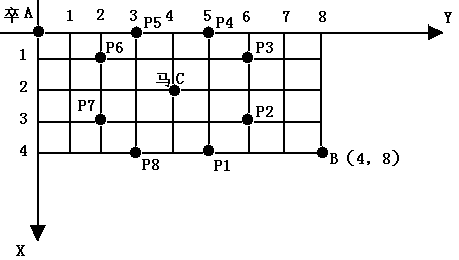一本通-1314:【例3.6】过河卒(Noip2002)(动态规划)¶
【题目描述】 棋盘上A点有一个过河卒,需要走到目标B点。卒行走的规则:可以向下、或者向右。同时在棋盘上的某一点有一个对方的马(如C点),该马所在的点和所有跳跃一步可达的点称为对方马的控制点,如图3-1中的C点和P1,……,P8,卒不能通过对方马的控制点。棋盘用坐标表示,A点(0,0)、B点(n, m) (n,m为不超过20的整数),同样马的位置坐标是需要给出的,C≠A且C≠B。现在要求你计算出卒从A点能够到达B点的路径的条数。

【输入】 给出n、m和C点的坐标。
【输出】 从A点能够到达B点的路径的条数。
【输入样例】 8 6 0 4
【输出样例】 1617
#include <iostream>
#include <vector>
#include <cmath>
#include <string>
#include <climits>
#include <cstdio>
#include <queue>
#include <stack>
#include <map>
#include <algorithm>
using namespace std;
vector<vector<long long> > res(21, vector<long long>(21));
vector<vector<int> > grid(25, vector<int>(25));
int m, n;
int x, y;
int direction[8][2] = {{2,1}, {1,2}, {-1,-2}, {-2, -1}, {-2,1}, {-1, 2}, {2, -1}, {1, -2}};
long long cal()
{
for (int i = 0; i <= m; ++i) {
if (grid[i][0]) {
while (i <= m) {
res[i++][0] = 0;
}
break;
}
else res[i][0] = 1;
}
for (int j = 0; j <= n; ++j) {
if (grid[0][j]) {
while (j <= n) {
res[0][j++] = 0;
}
break;
}
else res[0][j] = 1;
}
for (int i = 1; i <= m; ++i) {
for (int j = 1; j <= n; ++j) {
if (!grid[i][j]) {
res[i][j] += (grid[i - 1][j] ? 0 : res[i - 1][j]);
res[i][j] += (grid[i][j - 1] ? 0 : res[i][j - 1]);
}
}
}
return res[m][n];
}
int main()
{
std::ios_base::sync_with_stdio(false);
cin.tie(NULL);
cout.tie(NULL);
cin >> m >> n >> x >> y;
grid[x][y] = 1;
for (int i = 0; i < 8; ++i) {
int row = x + direction[i][0];
int col = y + direction[i][1];
if (0 <= row && row <= m && 0 <= col && col <= n) {
grid[row][col] = 1;
}
}
cout << cal() << endl;
return 0;
}
这道题思路不难,细节颇多。比如在设置障碍点为1的时候不能漏掉马初始的位置(自己第一遍就漏掉了),另外这道题没提到取模,则在20规模的情况下很可能造成整型溢出,所以需要使用long long的类型。
另外就是初始化的问题,第0行和第0列需要初始化,则只要有一个点能被马达到,则这一行或这一列后面的结果(res)都是0.